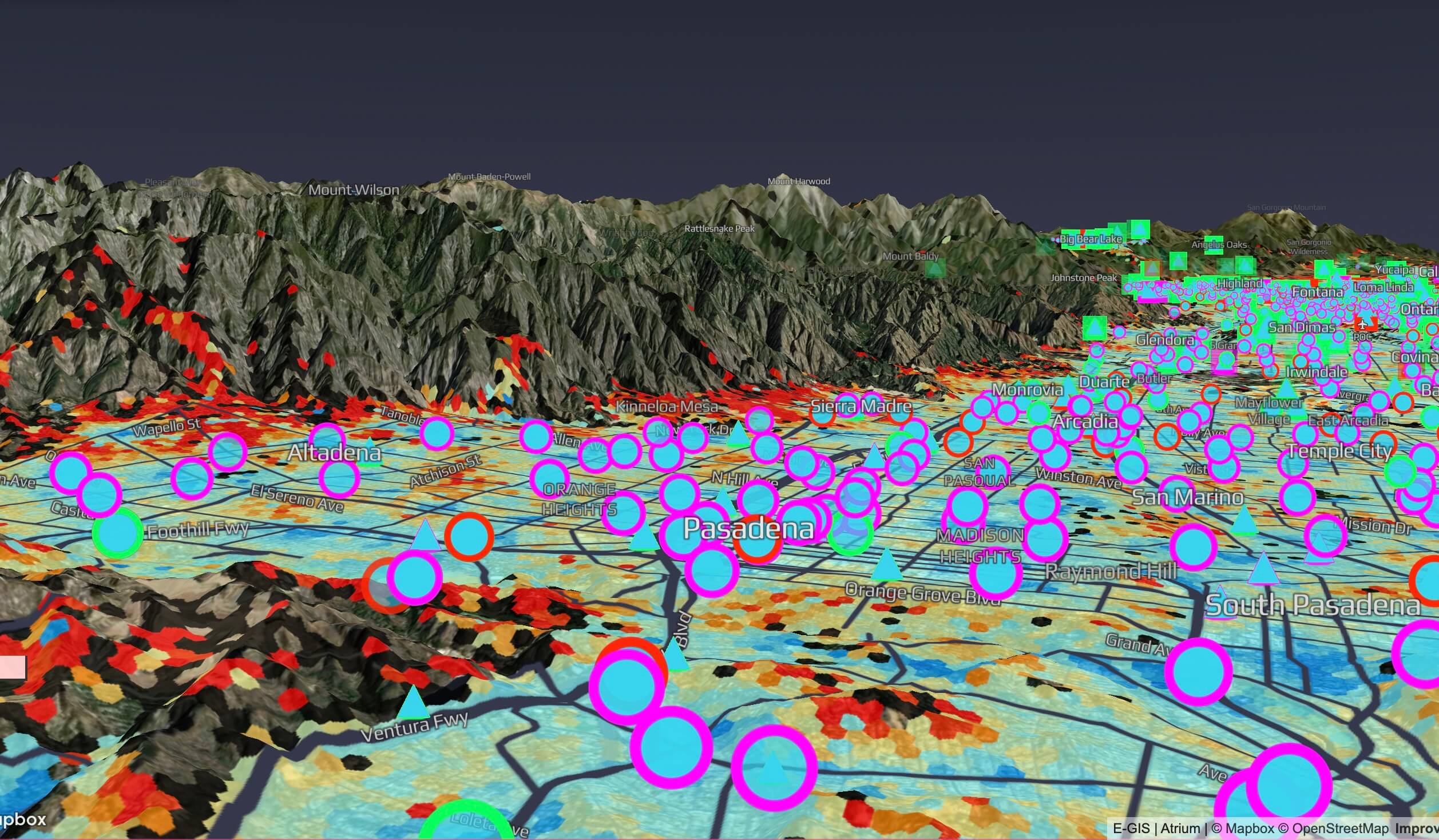This article was originally authored by Locana, which is now part of TRC.
Glean Insights from Your Big Data Using the Power of Location
The benefits of big data in 2022
For years, companies have been harnessing big data to glean insights that improve decision-making of every kind and at all levels, from entering new markets to building better products to delivering better services and experiences. And the trend, which includes geospatial data analytics, has only increased. Consider this: the global geospatial data analytics market estimated at $88.3 billion in 2020.
The convergence of geospatial solutions with big data accelerated in recent years because of advances in technical capabilities, as well as greater recognition of the value location provides to assimilate, organize, simplify, visualize, and transform big data into significant insights.
But exploiting big data, including spatial data, is more complex and nuanced than many realize. Businesses often struggle to manage the growing stores of information available to them. Indeed, 95% of companies mention the need to manage unstructured data as a business challenge. And the cost of poor data only compounds the issue, with the price to the U.S. economy reaching up to 3.1 trillion annually.
Why? For starters, many companies have been sold hype by software vendors that claim big data success is as simple as purchasing the right software (theirs) and pressing the proverbial “on” button. And dealing with the sheer volume of data on an ongoing basis is a daunting task where organizations can quickly get overwhelmed – and fall behind the competition.
Related Services

Big data presents big problems
Big data now touches our daily lives, from consumer-level use cases like movie and apparel recommendations to enterprise applications like monitoring global climate change, modeling land use and roadways impacts, and mapping crowdsourced data for emergency response.
It allows organizations to anticipate needs, monitor events, and respond to changing markets in real time. Businesses can interact with customers and prospects over various channels, including email, but also mobile push, ad retargeting, personalized websites, custom social audiences, and more. Yet attaining these capabilities are more difficult than you may imagine.
And a couple of critical factors contribute to this.
First, even tech-savvy companies with large IT staff and budgets typically lack institutional data science knowledge to design and build applications that can manage big data. There remain an inadequate number of data scientists or people with the data science skills to launch projects successfully.
In addition, the increase in available sources results in data deluge and redundancy for many organizations. This can range from tens of terabytes of data to hundreds of petabytes. It can include data of unknown value, such as Twitter data feeds, clickstreams on a web page or a mobile app, or sensor-enabled equipment.
Finally, the speed and variety of data only add to the complexity. Today data is received at an unparalleled pace. For instance, internet-enabled smart products operate in real-time or near real-time. And much of it is unstructured, lacking metadata and in formats that need to be unpacked. This requires additional preprocessing and the ability to infer metadata.
But with modern geospatial capabilities, you can bring clarity to chaos. You can use location to discover data patterns previously hidden in a deluge of complex data. You can generate map-based representations, visualize datasets over time, create event clusters, and identify hot spot activity. And regression tools to enable you to reveal relationships and predict future events. You can employ numerous mechanisms to automate processes and prepare data of all types, at any speed, for multiple purposes.

The geospatial edge to big data
Modern GIS makes it easier than ever to take advantage of big data. You can consume real-time data from sensors, social media, IoT, cameras, then apply tools to analyze and display it visually. And geo-cloud capabilities allow you to scale analysis and storage automatically. You can generate maps using imagery, remote sensor readings, statistical models, crowdsourced data, and more.
Moreover, you can effectively use diverse data types. You can apply distributed processing and deep learning capabilities for object detection, classification, terrain analysis, raster analysis, and more. This allows companies to take advantage of a wide array of data from satellites, drones, mobile devices, and more. All of these disparate data types can be harvested, processed, and set up in a system to serve your needs on an ongoing basis.
The dramatic wealth of available social media data offers tremendous opportunity for example. You can scrape and map geotagged Tweets, posts, searches, and other social “tracers” to gain a deeper understanding of communities and their interests.
In all scenarios, the vital component—and where many companies are lacking—is the specialized skills to collate and mine data in an efficient manner that moves from information to decision point. Moreover, it can require knowing where available data exists that’s fit for purpose, even to the point of having specialized data vendor relationships to properly consume that data.
For example, you may want to leverage satellite data to view geography over time. But that requires a specific time capture sequence and, in some cases, knowing when and how to ask data providers to adjust the collection times to meet your particular needs.
You also may want to use anonymized data but knowing the ever-changing governmental policies and guidelines you must follow, as well as ensuring how to follow them, can be daunting. Moreover, you could unintentionally break state, national, or international guidelines and laws without proper security and data sensitivity knowledge and skills.
How TRC can help
We can help you set up your big data foundation without having to spend extravagantly on resources and technology. We have deep expertise in geospatial innovation and data science, gained from working with a global client community, from large enterprises to early-stage startups and mid-sized businesses. We collaborate with customers to develop a detailed strategy and roadmap that includes identifying what, and in what form, your end users need.
First and foremost, we listen to your needs and performing a readiness assessment to map your current and desired state. Key questions include:
- Do you have the infrastructure to store data that you would use to extract new insights?
- Is there a service in cloud that meets your requirements that you can rely on?
- Are there existing models built that can be adapted to your needs?
- How will you surface insight?What BI platform/dashboards will help?
- Can you use cloud-based repositories to store this data?
Then, we help design and implement a geospatial architecture, connect technical specifications to business goals and needs, eliminate disconnected data silos, provide flexible data management, and employ governance controls that ensure long-term value.
Our staff is on the leading edge of field collection and data mining, with geo-analysts that can help you derive stats and create data-rich maps and visualizations that convey meaning. In addition, we can configure, design, and deploy your real-time analysis workflows.
We can help with your data processes, which involves knowing what infrastructure and data you have and what you need. This includes determining when, where, and how to deploy supporting backend platforms like data lakes or data warehouses. You can employ automated data pipelines, including where to access volunteered geographic information and crowdsourced data to tap into new sources of data.
We then build and train models so they are intelligent and reflect the idiosyncrasies of your business. That requires expertise often not located in-house. We can build map-based dashboards that allow you to perform ad hoc analyses in just a few clicks. This includes the ability to share your work with anyone.
Moreover, we can help with data security, which is paramount when handling big data. We adhere to data security and integrity standards during the entire data system design stage versus waiting later in the development to integrate data security protocols.
With this strategic roadmap in place, data models, pipelines, and infrastructure fine-tuned to your business, and full security and sensitivity measures installed from the start, companies are set up for long-term success. Simply put—what was previously too big or complex becomes streamlined and operational.

The TRC difference
Employing big data approaches to geospatial technology, including location analytics and mapping, allows superior analysis and decision-making for your business. You can do more with the vast volumes of data created daily by a global community of digital consumers.
Yet turning big data into big insights, especially leveraging the power of maps and location intelligence, is a challenge many companies face today. It requires more than simply software. It involves an expert approach that includes research, analysis, design, implementation, and deployment.
By building and deploying the right strategy using data science and sophisticated geospatial knowledge, manage, catalog, and process raw data in a fast, efficient manner that accelerates insights. Whether you work in commercial, clean energy, government, social benefit, utilities, or any other industry—the result is better business outcomes for your organization and customers.
Want to learn more? Contact us today or visit our services and industries pages.


